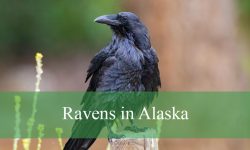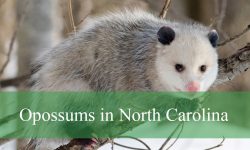Nature presents an incredible variety of colors and patterns, and few combinations are as striking as black bugs with white spots. These distinctive insects stand out in any environment, from gardens and forests to urban areas. Their bold patterns often serve purposes like deterring predators, blending into speckled surfaces, or mimicking more dangerous species.
Recognizing black bugs with white spots is not just visually interesting—it can also be practical. Some of these bugs are beneficial to plants and ecosystems, while others may pose risks as pests. Knowing how to identify them helps in making informed decisions about pest control or conservation.
This guide explores 22 fascinating black bugs with white spots, featuring clear photos and identification tips for each. It’s a helpful resource for gardeners, hikers, and anyone curious about the insects they encounter in daily life.
Different Types of Black Bugs With White Spots
Texas Eyed Click Beetle
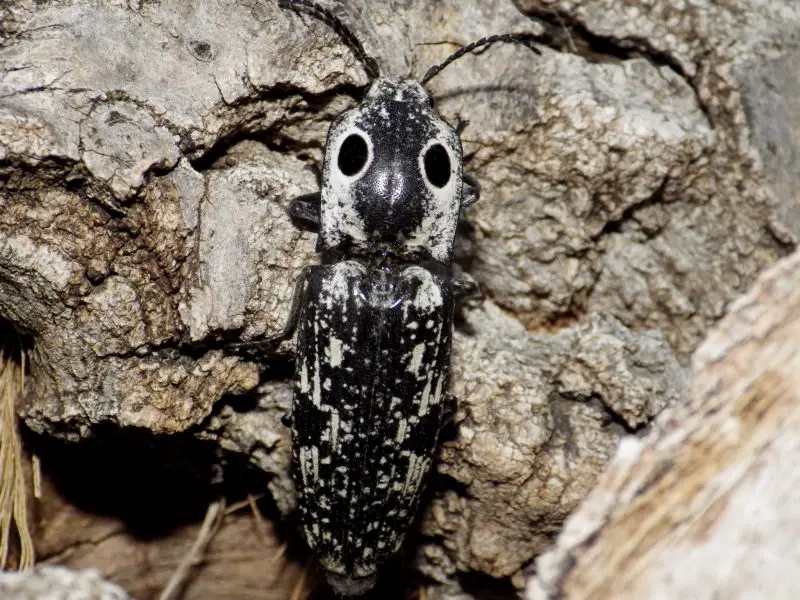
The Texas Eyed Click Beetle (Alaus lusciosus) is a closely related species to the Eastern-eyed Click Beetle, distinguished by its range and slightly different appearance. It features a flattened, elongated black body and oval white-ringed false eyes located on its pronotum. Adults can grow up to two inches long and often display dusty gray wings.
Like other click beetles, the Texas Eyed Click Beetle can snap its thorax to launch itself into the air, a mechanism used both as a self-righting method and a defense tactic. They are nocturnal by nature and are often drawn to artificial lights at night, which is when most people encounter them. During the day, they hide under bark or leaf litter.
Although they appear intimidating, these beetles are harmless to humans. The adults feed primarily on flower nectar, while their larvae (also known as wireworms) reside in decaying wood and feed on the larvae of other insects. Their presence is often an indicator of a healthy, decomposing forest floor, especially in warmer, southern regions of the United States.
Ocellated Tiger Beetle
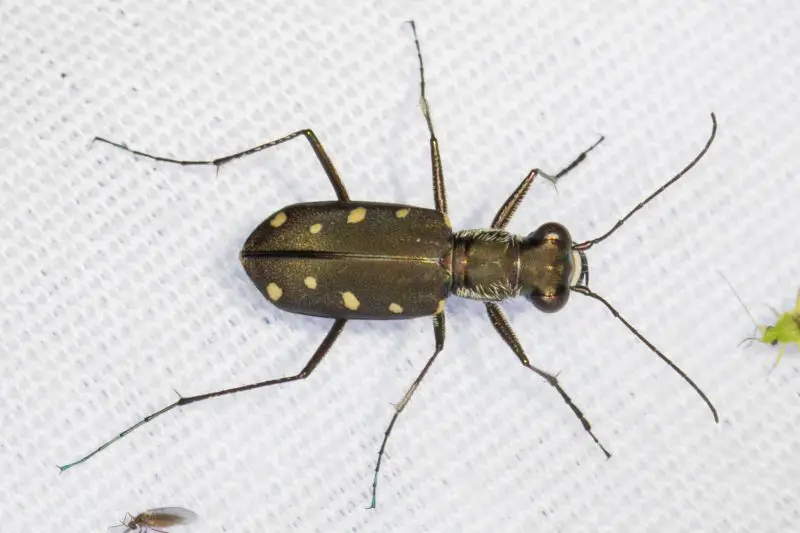
The Ocellated Tiger Beetle (Cicindela ocellata) is a sleek, fast-moving beetle known for its long legs and powerful mandibles. Adults measure about half an inch in length and are most commonly black or dark brown with white circular or irregular spots on their wing covers. Depending on lighting, their bodies may also reveal subtle metallic tones in bronze, green, or blue.
These beetles are agile hunters and are often seen darting across sandy terrain or open sunlit patches near rivers, trails, and sandbanks. Their heads are characteristically broader than their thoraxes, and they sport prominent compound eyes. When disturbed, they may fly short distances or quickly run away. If handled, they can deliver a painful bite with their strong jaws.
The Ocellated Tiger Beetle overwinters underground, creating burrows to avoid the cold. Females deposit eggs in the soil, and the larvae dig vertical burrows where they wait to ambush small arthropods. Found throughout North America, they are particularly common in open, sandy environments where the soil remains compact and dry enough to support their burrowing lifestyle.
Tumbling Ragdoll

The Tumbling Ragdoll (Mordella marginata), commonly referred to as the tumbling flower beetle, is a small, dark beetle known for its erratic movements when disturbed. Adults reach up to 7 millimeters in length and have a distinctive humpbacked and wedge-shaped body, with a tapered abdomen ending in a point. Their bodies are covered in fine setae, giving them a slightly fuzzy appearance.
These beetles are often seen basking on flowers where they feed on pollen and nectar. When touched or startled, they display their signature tumbling motion, which involves flipping and bouncing erratically to evade threats. This motion not only confuses predators but also makes the beetles difficult to catch. Despite their nervous energy, they are harmless and quite delicate.
Mordella species are part of a larger family comprising over 1,500 known species worldwide. They tend to favor meadows, garden beds, and wildflower patches, particularly during warmer months. Larvae typically develop inside decaying wood or plant stems, feeding on decomposing organic matter. Their jumping behavior is so unique that they are often mistaken for fleas or springtails by casual observers.
Banded Alder Borer

The Banded Alder Borer (Rosalia funebris) is a striking beetle species easily identified by its long, narrow black body with three distinctive white bands across its back. The thorax is bright white, marked with a prominent black dot in the center. Their black and white banded antennae are particularly eye-catching, with males having significantly longer antennae than their body length, while females possess proportionally shorter ones.
This beetle is primarily found in the western regions of North America, including states like California, Alaska, New Mexico, and Washington. Adults are typically active from spring through late summer, commonly seen on alder tree bark and nearby vegetation. Interestingly, they are known to rest on freshly painted surfaces, possibly drawn to the volatile organic compounds found in paint.
Adult Banded Alder Borers feed on flower nectar, while their larvae tunnel through and consume decaying hardwood, playing a role in decomposition. When threatened or handled, they produce a sharp hissing sound resembling air escaping a tube, which is thought to deter predators. Despite their intimidating appearance and noise, they are harmless to humans and not considered pests in residential areas.
Hairy Rove Beetle
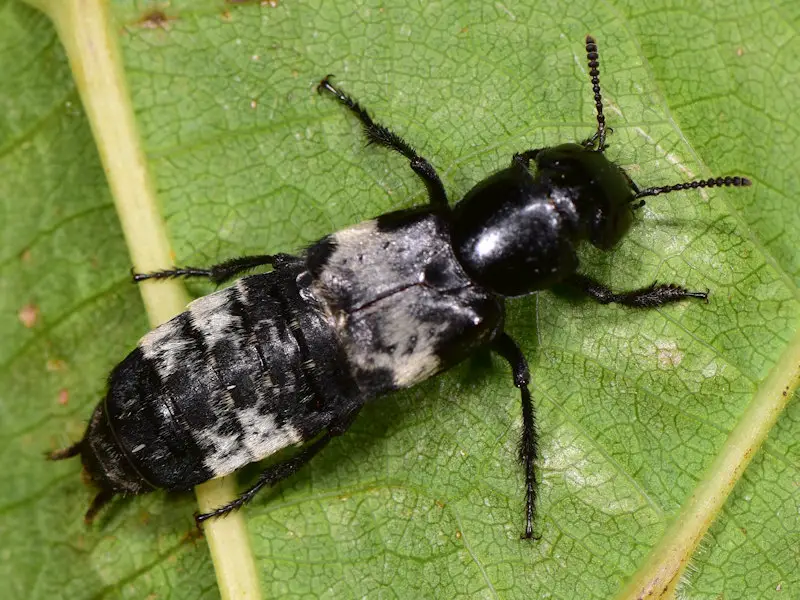
The Hairy Rove Beetle (Creophilus maxillosus) is a robust predatory insect known for its glossy black body and large, prominent eyes. Growing up to 18mm long, it features beaded antennae with eleven segments and powerful mandibles capable of delivering a painful bite. Covered in fine hairs, this beetle has a flexible abdomen that curves upward like a scorpion’s when it feels threatened.
Commonly seen from spring to autumn in wooded areas across the eastern United States, these beetles are fast and agile. They can run quickly and take to the air with ease when disturbed. Unlike many beetles, they undergo a rapid development cycle—eggs hatch in about four days, larvae develop over two weeks, and pupation lasts another sixteen days.
Hairy Rove Beetles are scavengers and predators, often found near carrion where they consume maggots and other soft-bodied insects. Their role in the ecosystem is important as they help reduce decomposing animal material. Both the larvae and adults are active hunters, using their sharp mandibles to tear apart prey. Their presence is a sign of active decomposition and healthy scavenger populations.
Spotted Lanternfly
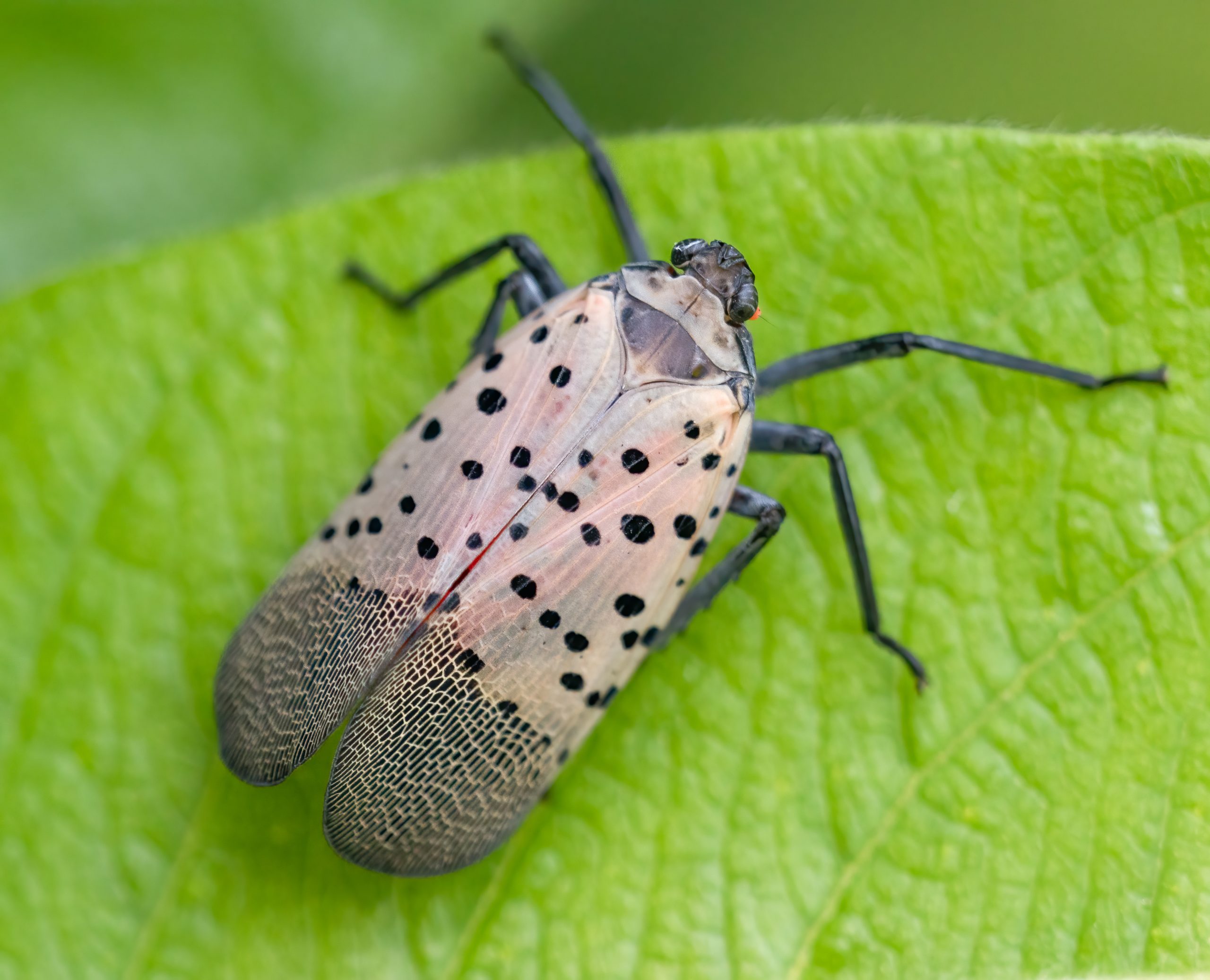
The Spotted Lanternfly (Lycorma delicatula) is a visually striking insect native to regions of China but has spread invasively to countries like South Korea, Japan, and the United States. It poses a significant threat to agriculture, especially vineyards and orchards. Its preferred host is the invasive Tree of Heaven (Ailanthus altissima), although it also targets numerous hardwood trees and fruit-bearing plants.
Nymphs start out with a black body and distinct white dots, becoming more colorful with age as they develop red patches and eventually take on a slate-gray appearance with spotted forewings and red underwings. Adult lanternflies are about 1 inch long and 0.5 inches wide. When resting, their red hind wings are typically hidden beneath the speckled outer wings but become visible when they take flight or are agitated.
In North America, this insect has become a serious nuisance since its accidental introduction, with first reports dating back to 2014 in Pennsylvania. It feeds by piercing plant tissues and extracting sap, weakening trees and leading to mold growth from the sugary waste it excretes. With few natural predators in its new environment, population control has proven difficult, making it a priority pest in many Northeastern states.
Eastern Eyed Click Beetle
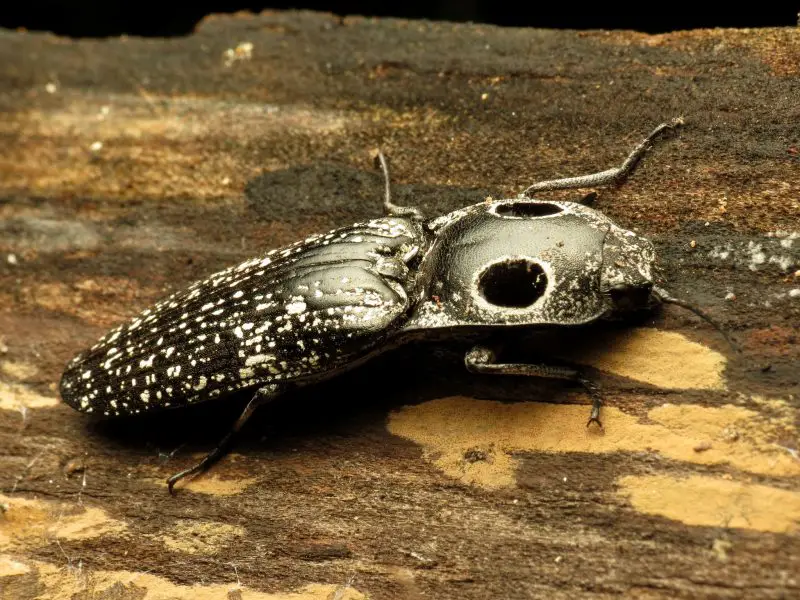
The Eastern Eyed Click Beetle (Alaus oculatus) is a large, black beetle recognized by its long body and two false eye spots near the top of its thorax. These oval markings are outlined in white, helping to deter predators by mimicking the eyes of a larger animal. Adults can reach lengths of up to 45 millimeters and are typically found in wooded regions.
When threatened, this beetle employs a unique defense: it arches its back and snaps its thoracic joint, creating an audible “click” and flipping itself into the air. This behavior not only startles predators but also allows the beetle to escape from its back if overturned. While adult beetles feed lightly on nectar and sap, the larvae are highly predatory.
The larvae, commonly called wireworms, live in decaying logs and consume the grubs of wood-boring beetles, sometimes devouring hundreds over their development. This makes them beneficial in forest ecosystems, as they help reduce populations of destructive tree pests. The Eastern Eyed Click Beetle is widespread throughout forests in North and Central America and is typically encountered during warm months.
Eight-spotted Flea Beetle
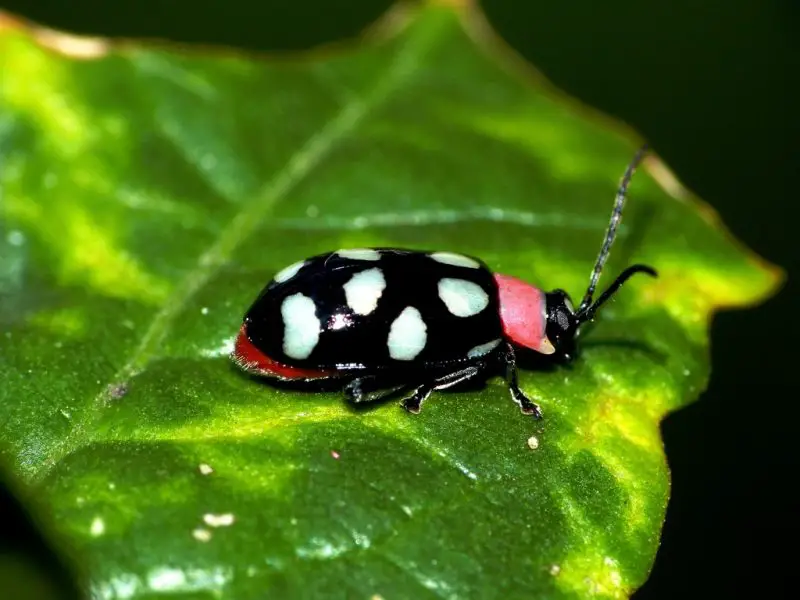
The Eight-spotted Flea Beetle (Omophoita cyanipennis) stands out with its glossy black wing covers (elytra) adorned with eight bold white or cream-colored spots. The head of this beetle is black and white, while its thorax is a contrasting orange, making it one of the more colorful members of the flea beetle group. Adults are small, typically measuring only a few millimeters in length.
Native to regions in Central America, the Caribbean, and parts of North America, these beetles are found in suburban gardens, open meadows, and near woodland edges. They get their name from their powerful hind legs, which allow them to jump away from danger like fleas. You’ll often see them around leafy plants, especially in sunny, open environments.
While visually appealing, Eight-spotted Flea Beetles feed on plant material, including leaves and stems. In large numbers, they can cause significant damage to crops and ornamental plants. However, they play a vital role in the food chain, serving as prey for spiders and predatory insects. Their mobility and vibrant patterning make them one of the more easily noticed beetles in their habitats.
Leconte’s Haploa Moth
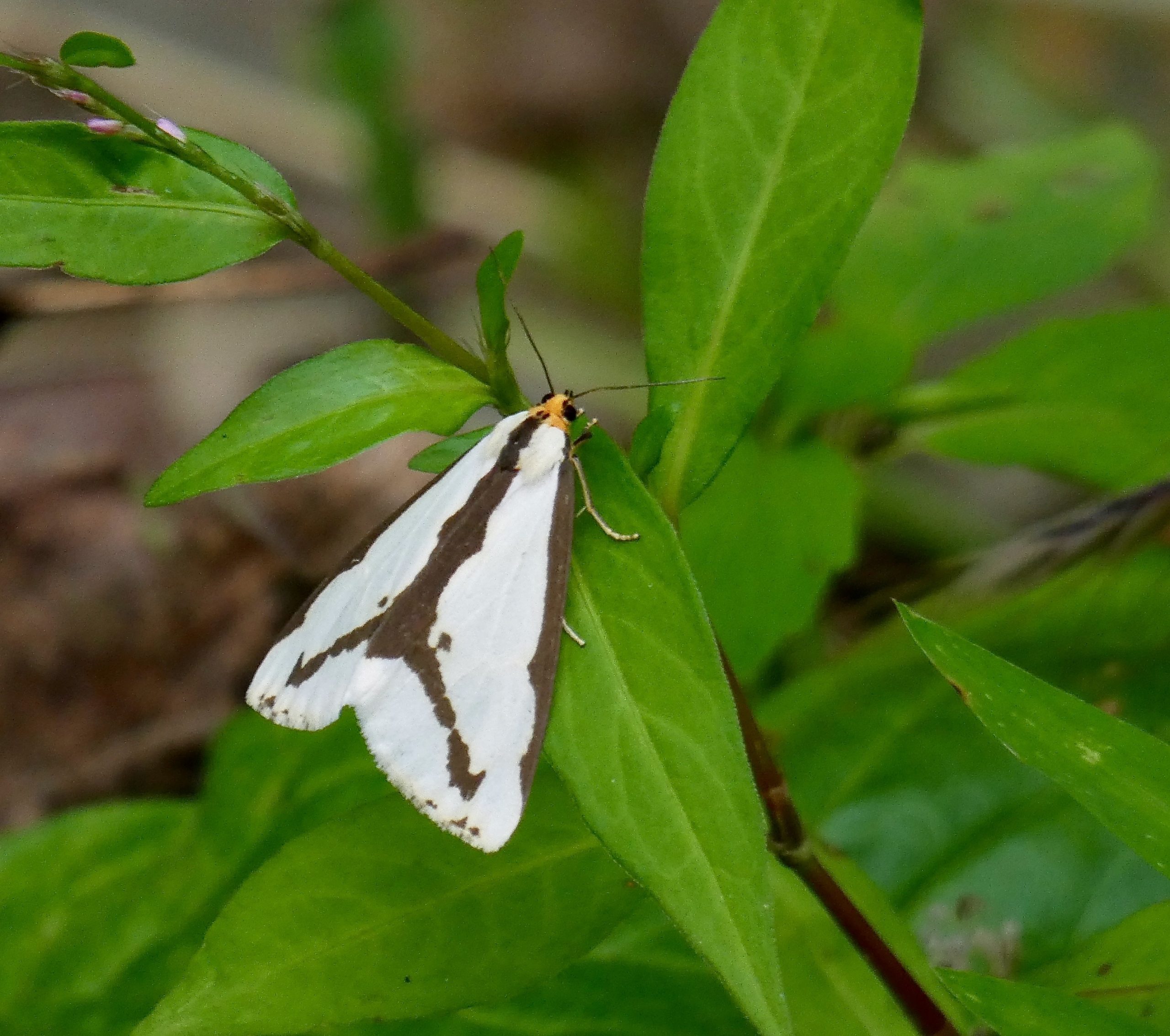
Leconte’s Haploa Moth (Haploa lecontei) is a beautifully patterned moth that adopts a triangular shape when at rest. Its white wings are edged and streaked with bold black markings, and a central black line runs halfway down the body. Some individuals display striking black wings dotted with white spots instead, showing variation within the species.
This moth is found across parts of North America, particularly in woodland and scrubby areas where host plants are abundant. Females lay clusters of yellow eggs on the leaves of shrubs and trees. The resulting caterpillars are dark with yellow stripes running along their back and sides. These caterpillars are known to feed on a variety of trees and shrubs, including willows and poplars.
As adults, Leconte’s Haploa Moths are nocturnal and are drawn to artificial lights. They are typically seen from late spring to mid-summer. Though they are not aggressive and pose no threat to humans, their caterpillars can occasionally be seen in large numbers on ornamental or wild plants, where they feed collectively and grow quickly to their full size of nearly 50mm.
White-spotted Fruit Chafer
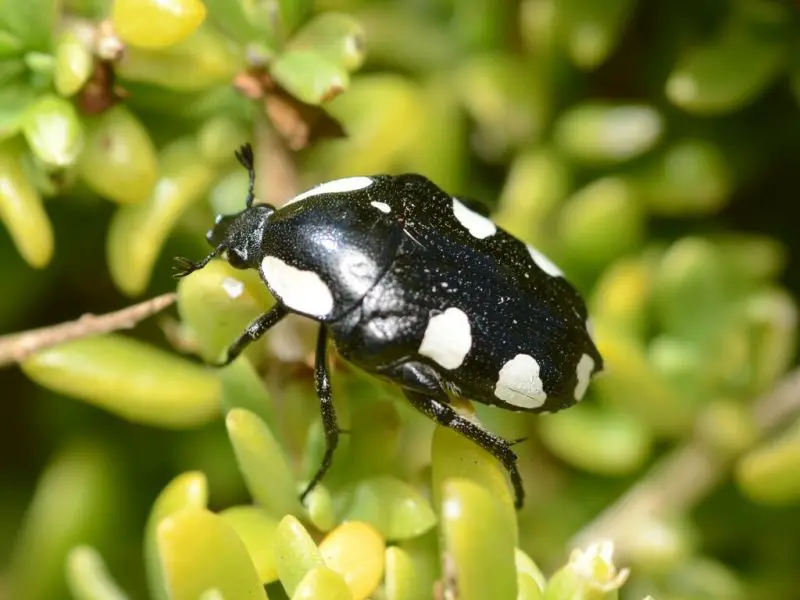
The White-spotted Fruit Chafer (Mausoleums amabilis) is a shiny, black beetle adorned with distinct white spots across its body, creating a striking contrast that makes it easy to recognize. These beetles are native to Southern Africa and are found in a variety of habitats, including woodlands, gardens, and open grasslands. They are especially drawn to sugary substances.
Adults often gather on blooming flowers, fruit baits, and tree sap flows, where they feed on nectar and decaying fruit. They may occasionally be found in bird nests, taking advantage of the rich organic matter. Their feeding activity is not usually harmful but may be considered a nuisance in orchards or gardens with ripe fruit.
The larvae develop in animal dung, particularly from horses and goats, and resemble typical scarab grubs—white, C-shaped, and segmented. This development strategy allows them to take advantage of nutrient-rich organic waste, contributing to the decomposition process in their environment.
Marbled White
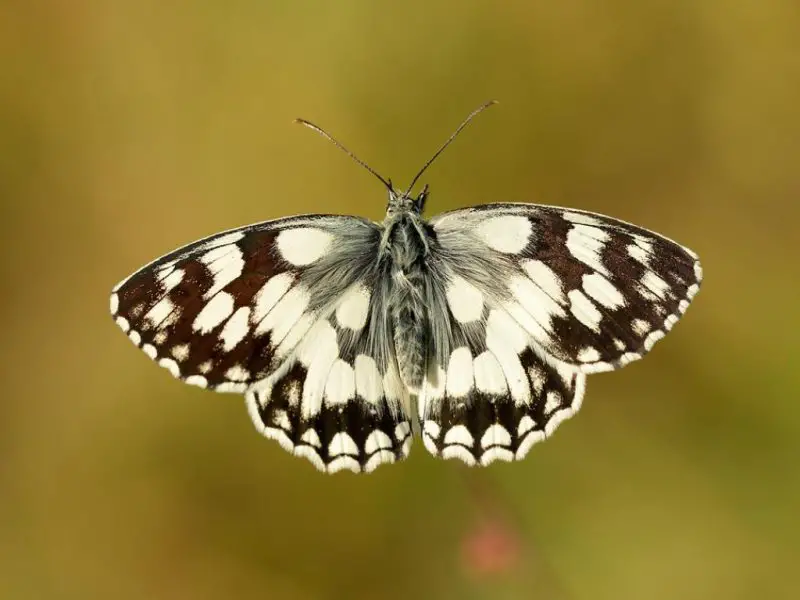
The Marbled White (Melanargia galathea) is a beautifully patterned butterfly native to Europe, parts of Asia, and Iran. It is most commonly seen fluttering through meadows, forest edges, and grassland clearings during the summer months. In the United Kingdom, its population has expanded significantly since the late twentieth century, especially in areas with traditional hay meadows.
Adults exhibit a checkered wing pattern of dark brown or black against a white background, giving them a marbled appearance. The underside of their wings is a lighter gray or tan, which helps camouflage them when they rest with wings closed. With a wingspan reaching up to 56mm, they are considered medium-sized and easily observed when visiting flowers.
The caterpillars are yellow-green or bright green with darker longitudinal lines and a pale brown head. They feed primarily on grasses and are active mostly at night. After overwintering as young larvae, they resume development in spring and pupate among leaf litter or soil before emerging as adults.
Arhaphe arguta
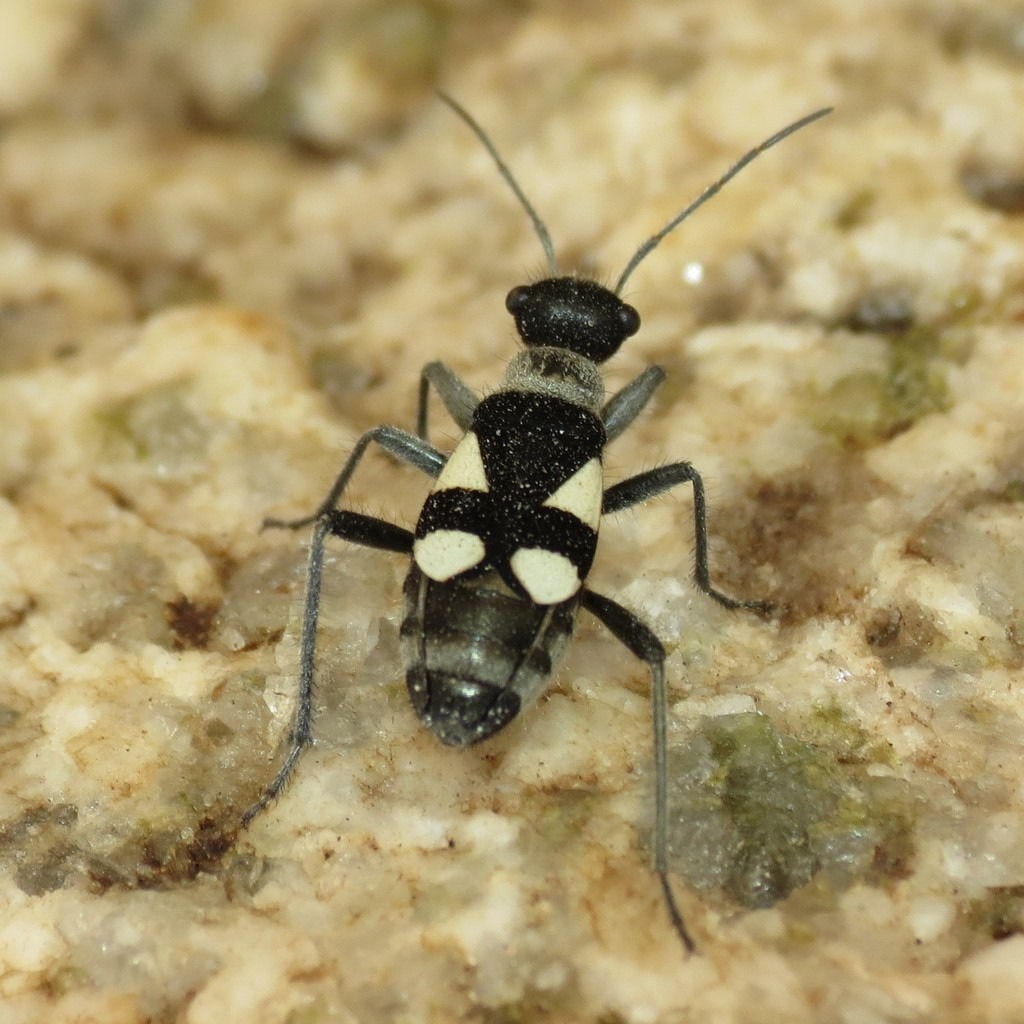
Arhaphe arguta is a member of the Largidae family, a group of colorful plant bugs that often go unnoticed due to their small size and discreet habits. This particular species is notable for producing sound by rubbing its forewings against the costal margin, a behavior known as stridulation. This subtle noise can sometimes be heard when they are disturbed or communicating with each other in dense vegetation.
They are widely distributed throughout the United States, with sightings extending into parts of Central and South America. These bugs are typically seen on low plants, where they feed on plant juices using their piercing-sucking mouthparts. Their presence is generally non-destructive and does not usually cause concern for crops or ornamentals.
Adults are slender and soft-bodied, often displaying earthy tones such as brown or gray, which help them blend into their environment. While not flashy in appearance, their behaviors and structural features are of interest to entomologists studying sound communication and plant-insect interactions.
Six-spot Ground Beetle
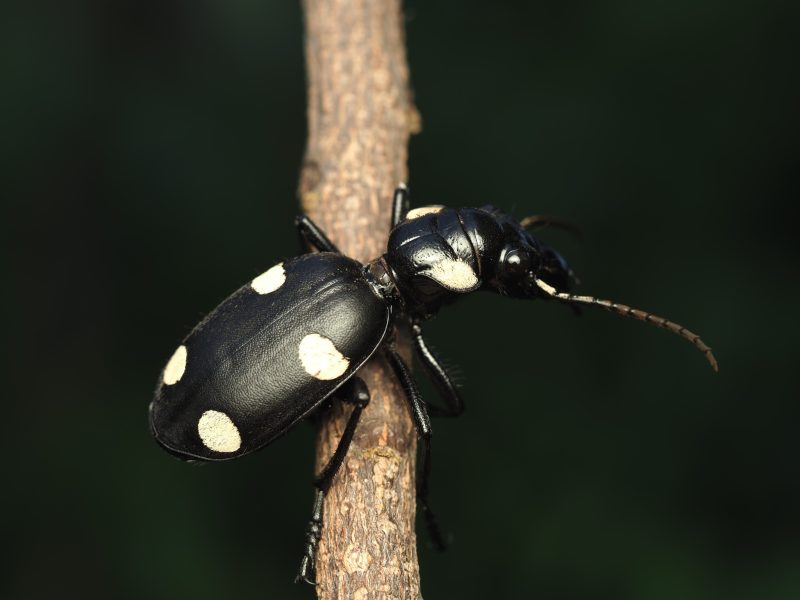
The Six-spot Ground Beetle (Anthia sexguttata) is a large, robust insect known for its bold appearance and predatory lifestyle. Measuring up to 4 centimeters in length, this beetle is easily recognized by its black body and six prominent white spots—four on the elytra and two on the thorax. Its striking coloration serves as a warning to predators that it is not an easy target.
Native to South Asia, it is particularly common in India’s dry regions and scrub forests. Adults are nocturnal hunters, using their powerful mandibles to prey on insects, snails, and other small invertebrates. Their presence in agricultural zones is often welcomed due to their role in controlling pest populations.
The larvae are flattened and equipped with oversized heads and large jaws, making them effective subterranean predators. They live in the soil and hunt for soft-bodied prey. Despite their fearsome appearance, they are not dangerous to humans and are a beneficial part of the natural ecosystem.
Buck Moth
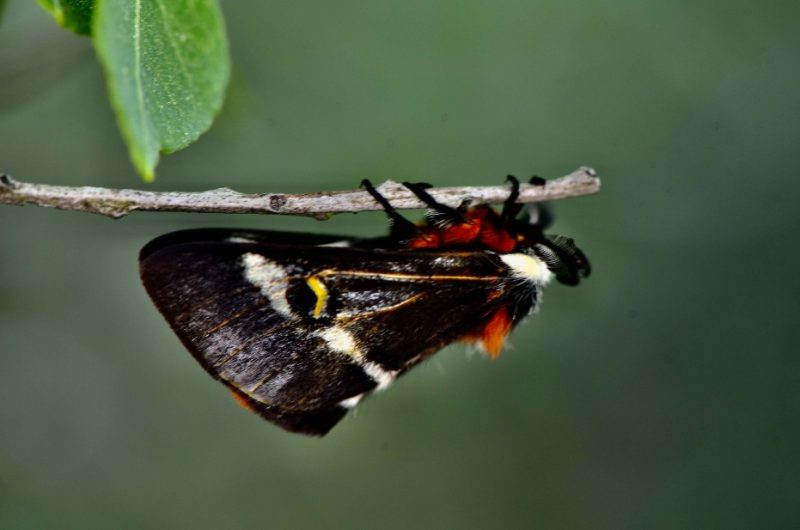
The Buck Moth (Hemileuca maia) is a large, dramatic moth typically found in oak forests throughout much of the eastern and southern United States. Its forewings are black with bold white bands, while the hindwings are reddish-orange with black edges. This species is most commonly active during the fall, unlike many other moths that are seen in summer.
Buck Moth caterpillars are spiny and dark, with clusters of urticating hairs connected to venom glands. These spines can cause painful stings that may result in itching, burning, or mild allergic reactions in sensitive individuals. The larvae primarily feed on oak leaves, especially species like scrub oak, live oak, and white oak, making them common in oak-dominated woodlands.
While the adult moths are not harmful and do not feed, their caterpillars can become a nuisance in some areas, especially where oak trees are abundant in urban or suburban settings. In Louisiana, for example, the use of live oaks as street trees has led to periodic outbreaks of Buck Moth caterpillars. Due to habitat loss, they are now listed as endangered in Connecticut, highlighting the importance of conservation in forest ecosystems.
Polka-Dot Wasp Moth

The Polka-Dot Wasp Moth (Syntomeida epilais) is a day-flying moth known for its vivid coloration and mimicry. Originally native to the Caribbean, it has become widespread in parts of North America, particularly in Florida and South Carolina. It occasionally shows up in other southern states like Texas and Mississippi. This species is closely associated with ornamental oleander plants.
Adults are glossy metallic blue with distinct white spots on their wings and back. The tip of the abdomen is bright red, creating a strong resemblance to a stinging wasp. This mimicry helps deter predators, even though the moth itself is entirely harmless. Their bright coloration and active daytime behavior make them easily recognizable.
The caterpillars are striking orange with tufts of dark hairs, giving them a fierce appearance. Despite their look, they do not sting or pose any threat to humans. However, their feeding habits can be destructive, especially on oleander. They also consume foliage from desert rose and devil’s potato, causing significant defoliation when present in large numbers.
Grape Leaffolder Moth
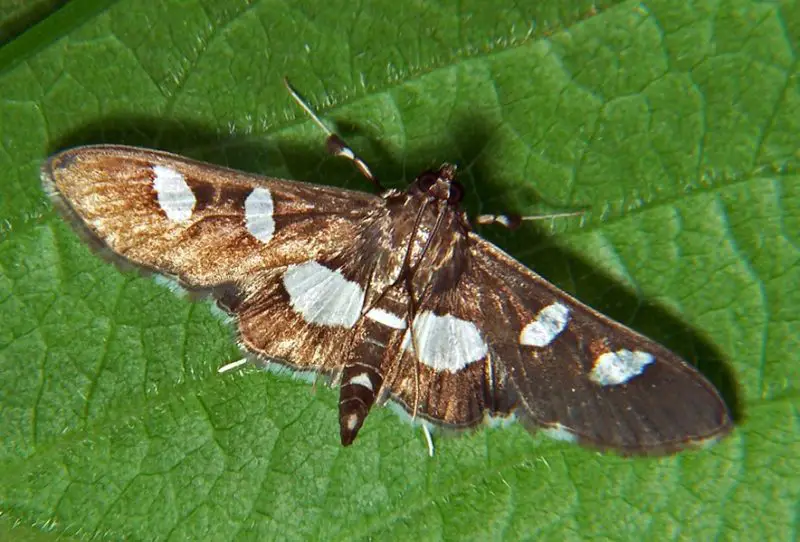
The Grape Leaffolder Moth (Desmia funeralis) is a member of the Crambidae family and is often seen fluttering in vineyards and wooded areas across the eastern and southern United States. It is also found as far north as southeastern Canada. This moth is active from spring through early fall and plays a role in grape cultivation as a minor pest.
Adults have a wingspan of up to 28mm and are mostly dark brown or black with white markings on their wings and abdomen. Females can be distinguished by a curved or pitched white spot on the hindwings. These moths are diurnal and are frequently observed flying during sunny days, which is somewhat unusual for moths.
The larvae are leafrollers that feed primarily on grape leaves. They fold the leaves over themselves using silk threads, feeding from within the shelter they create. This behavior can damage grape crops by reducing the leaf surface area available for photosynthesis. However, infestations are typically small and manageable in most vineyards.
Peppered Jumping Spider
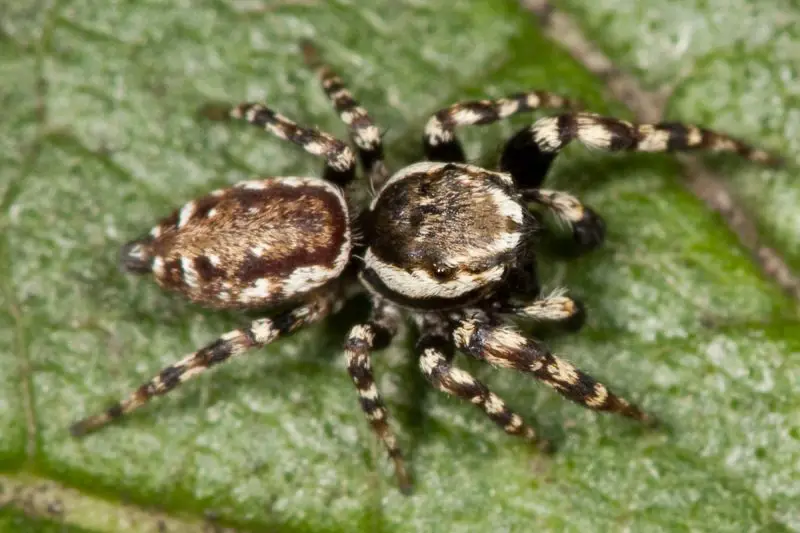
The Peppered Jumping Spider (Pelegrina galathea) is a small, agile predator commonly found throughout the eastern and central regions of North America. It prefers sunny meadows, grasslands, and gardens where it can actively hunt during the day. This spider is often seen in open areas where it uses its strong vision and jumping skills to its advantage.
Adults are dark-colored, ranging from black to mottled gray, with white speckles that give them a salt-and-pepper appearance. Like all jumping spiders, they have large forward-facing eyes, allowing them to judge distances precisely before leaping onto their prey. Their unique movement patterns and frequent head tilting give them a curious and intelligent appearance.
Although they are not aggressive, these spiders can deliver a small bite if roughly handled, but it is not considered medically significant. They play a beneficial role in gardens and fields by feeding on insects like flies and aphids. Their presence often goes unnoticed unless closely observed, due to their small size and stealthy hunting habits.
Garden Fleahopper
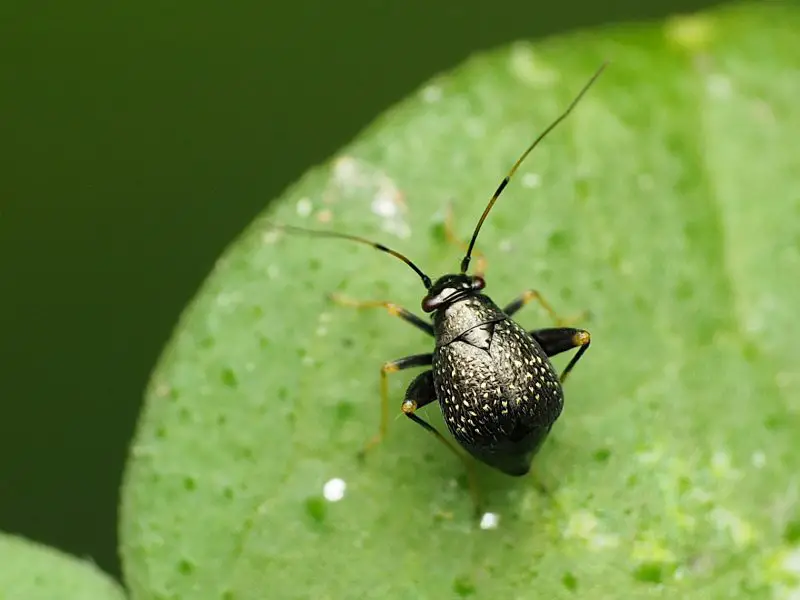
The Garden Fleahopper (Microtechnites bractatus) is a tiny, fast-moving plant bug that can cause visible damage to many garden crops. It is widespread in the eastern United States and southern Canada, where it thrives in agricultural and backyard environments during the warmer parts of the year. Its rapid life cycle allows populations to build up quickly under ideal conditions.
Adults are shiny black with contrasting yellow or greenish legs and antennae. Males are more slender and measure just over 2mm, while females are slightly bulkier. These insects get their name from their jumping behavior, as they leap away quickly when disturbed, making them difficult to catch or control without close inspection.
They feed on a wide variety of plants, including legumes, cucumbers, tomatoes, and root crops like potatoes and beets. Damage is caused by piercing the plant tissues and sucking out the juices, leading to stippling or tiny pale spots on the leaves. Heavy infestations can lead to leaf yellowing, wilting, and in severe cases, plant death.
Mormidea v-luteum
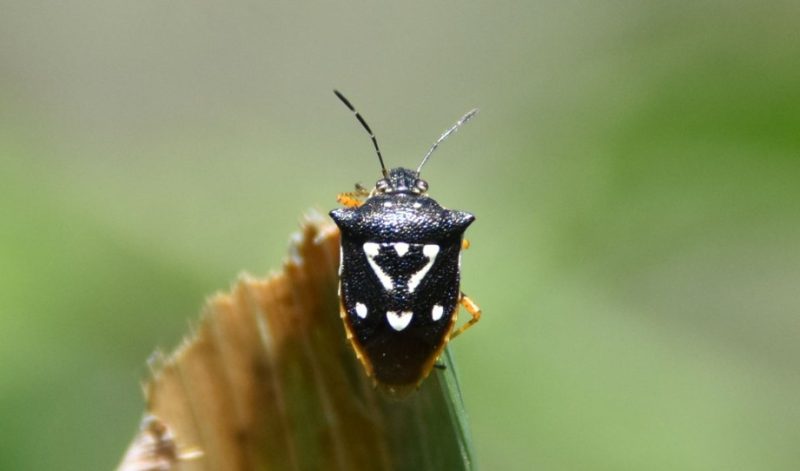
Mormidea v-luteum is a shield bug species that has been known to agriculture since the late 18th century. It is commonly associated with cereal crops, particularly rice and ryegrass, and is frequently reported in areas with large-scale grain production. Its feeding activity can have significant economic impacts if left unchecked.
This species is easily recognized by its tough, shield-like body, mostly black with small white spots across the back. Its legs and underside have a brownish tint. The body is rigid and oval-shaped, giving it a beetle-like appearance. Adults are often seen walking on stems or hiding among lower leaves of host plants.
Both nymphs and adults feed by piercing plant stems and extracting sap, which disrupts nutrient flow and slows plant development. When infestations are heavy, plants may exhibit reduced vigor and lower yields. Due to their damage potential, Mormidea v-luteum is monitored closely in rice-growing regions.

